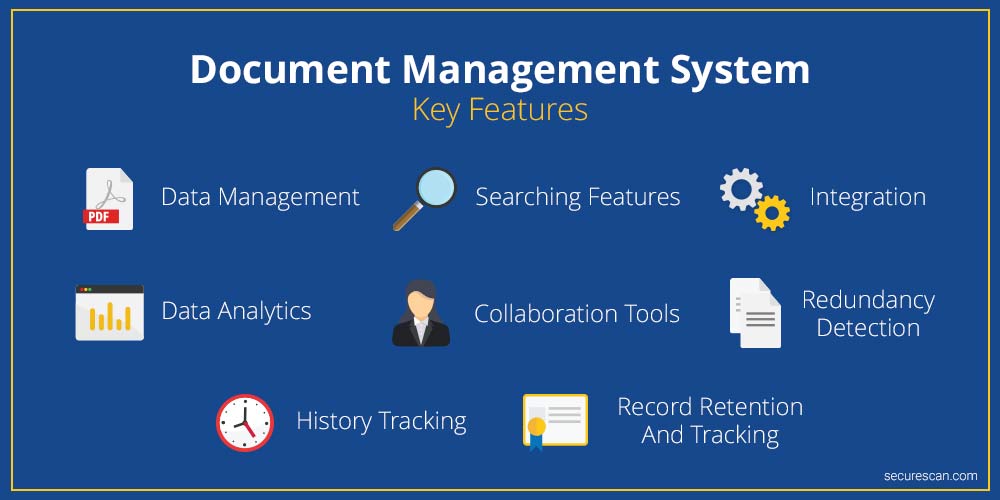Transitioning from paper to digital record-keeping is an exciting step for any business. Think of the space you’ll save and how much easier it will be to locate important documents.
However, scanning your documents is just the beginning. To truly benefit from your new digital system, you’ll need to choose the right document management system to store and organize your files effectively.
This choice can feel overwhelming, especially if you’re not familiar with the available options for managing digital files.
This guide is designed to clear up that confusion, providing a straightforward look at different document management systems and offering practical advice on picking the perfect one for your business needs.
What is a Document Management System?
A document management system (DMS) is software designed to store, manage, and track electronic documents and images of paper-based information captured through scanning.
These systems provide an organized structure to catalog your digital documents, making them easier to locate, access, and manage.
With a DMS, you can streamline workflows, improve efficiency, and enhance the security of your business documents, all while reducing or eliminating the need for physical documents.
What Are the Different Types of Document Management Systems Available?
There are a wide variety of document management systems available on the market, each designed to meet specific business needs and operational requirements. Generally, these systems can be categorized into one of the following four types:
Basic Document Management Systems cater to small and medium-sized businesses by offering only the most essential features, such as document storage, indexing, and retrieval. These systems are designed to be straightforward to set up and easy to use, providing a great starting point for businesses new to document management. They typically include features for document tracking, version control, and basic security measures, which are sufficient for moderate document flow.
These kinds of systems are well-suited for small retail shops, independent law offices, and start-up companies seeking simple, efficient tools to manage their growing volumes of documents.
Medical Records Systems, commonly referred to as electronic medical record systems (EMR), are specialized for healthcare environments and designed to handle sensitive patient data securely. These systems adhere to strict regulatory standards and data privacy protection regulations, ensuring that all patient information is stored, accessed, and shared in compliance with legal requirements.
Common features of an EMR often include integration with medical billing systems, tools for managing patient charts and histories, and comprehensive electronic medical records capabilities.
These systems are typically used when digitizing patient charts, dental records, and other medical applications.
Enterprise Content Management Systems are a powerful upgrade for businesses seeking enhanced capabilities in their document management. These systems come equipped with advanced features such as workflow automation, in-depth compliance tracking, and collaboration tools to support the complex document management needs typically found in larger organizations.
They’re perfect for larger organizations or those in sectors like finance, government, or manufacturing, where the complexity and volume of documents require a more sophisticated approach to management.
Cloud-Based Document Management Systems offer maximum flexibility and scalability, essential features for businesses operating across multiple locations or those requiring remote access to documents. These systems enable businesses to store vast amounts of data cost-effectively while providing near-instantaneous access to documents from anywhere in the world.
These systems come equipped with enhanced security features that ensure safe data access, even over the internet. Additionally, they facilitate easy and cost-effective data integrity maintenance by supporting automated backups and data redundancy at very low costs.
As you can see, each type of document management system offers unique features tailored to specific business needs and industry requirements. Gaining a better understanding of these basic types of systems makes it easier to evaluate their specific features and determine which best fits your organizational goals and operational strategies
Features To Look For In a Document Management System
Now that you understand the basic types of document management systems available, you can start evaluating software in one of these categories based on the features you need for your document management system. Here are a few key points to consider when shopping for the right system for your business:

Data Management
The document management system you choose should allow your businesses to store, organize, and manage all of the data and documents your business deals with, ensuring that all of your data is accessible and manageable from a single place.
Integration
Integration with other systems used by your organization is important for streamlining operations and improving data management. The right document management system should seamlessly integrate with other existing software applications, like ERP systems, accounting software, and CRM platforms that you already use to provide a unified approach to data management and accessibility.
Collaboration Tools
To enhance teamwork and productivity, a document management system should include features that support the kind of collaboration your business requires.
This includes sharing files, simultaneous editing capabilities, and communication tools built directly within the system, helping various teams to work together effectively regardless of their physical location.
Searching Features
No matter how much data you need to store, accessing it efficiently is crucial. For this reason, it’s important to consider the search capabilities of a system. The system you select should offer advanced search options, including keyword, metadata, and full-text searches, enabling users to locate documents quickly and efficiently..
History Tracking for Records
To maintain accurate records and track document changes, history tracking is indispensable. This feature records who accessed or modified a document, what changes were made, and when these activities occurred, providing a transparent audit trail for compliance and operational purposes.
Automatic Record Retention
Adhering to industry regulations and legal requirements is essential for any business. Features like automatic record retention periods are critical for maintaining compliance. This functionality ensures that documents are retained for the exact required duration and no longer, streamlining adherence to laws and regulations and simplifying the compliance process.
Redundancy Detection
To maintain data integrity and reduce clutter, redundancy detection identifies and removes duplicate documents or data within the system. This not only saves storage space but also enhances data quality and retrieval accuracy.
Analytics and Data Tools
Advanced analytics and data tools transform raw data into actionable insights, helping businesses understand document usage patterns, optimize processes, and make informed decisions. These tools can provide dashboard visuals, report generation, and metrics analysis to track the system’s effectiveness and impact on productivity.
Incorporating these features into your document management system can significantly improve operational efficiency, ensure regulatory compliance, and foster a collaborative work environment, all while maintaining high standards of data security and management.
Choosing the Right System for Your Business
Now that you are familiar with the available features, it’s time to select your document management system. This decision involves balancing the features that are important to you with a careful assessment of your business’s specific requirements and challenges.
Industry-Specific Requirements: It’s essential to consider the distinct needs of your industry when selecting a document management system. For instance, legal firms might prioritize features that support the secure storage and rapid retrieval of case files, while educational institutions could benefit more from systems that enhance collaboration and document sharing among staff and students.
Volume and Accessibility: The amount and frequency of document access are crucial factors in choosing the right system. Businesses that handle large volumes of documents or require frequent access by multiple users should look for systems with robust search capabilities and high-performance databases to ensure quick retrieval times without performance lags.
Integration Capabilities: The ability of a document management system to integrate with existing software is vital for maintaining workflow continuity and enhancing productivity. A system that seamlessly integrates with your current applications reduces the learning curve for staff and helps in maintaining consistency and accuracy of data across platforms.
Security and Compliance: Ensuring that your chosen system adheres to industry standards and legal requirements is crucial, especially if you deal with sensitive or personally identifiable information. Look for systems that offer encryption, user authentication, and audit trails to help comply with regulations pertinent to your industry.
By carefully considering these factors, businesses can choose a document management system that not only fits their current operational needs but also scales with their future growth.
How SecureScan Can Help
With over 22 years of experience in document scanning, SecureScan has spent more than two decades advising businesses on how to manage their documents post-digitization.
Whether you are looking to streamline your document management processes or ensure compliance with industry standards, SecureScan can provide tailored solutions that fit your business needs.
For more information or to get a free quote, contact our scanning specialists today. They are ready to help you determine the next steps to take in your journey towards effective document management.
